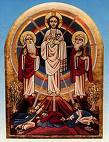God's Dwelling
[homily preached Thursday morning on the text Ex 40: 16-21, 34-38: "The cloud covered the meeting tent and the glory of the LORD filled the Dwelling."]
The Fathers of the Church had a fascination with the physical construction of both the temple in Jerusalem and the dwelling tent that held the ark of the covenant while the Israelites sojourned in the wilderness. This fascination often comes out indirectly, as when a Father, in the midst of a theological argument, suddenly mentions something about how many cubits long was the ark of the covenant or how many curtains were on each side of the Dwelling. As an analogy, we note that the medieval Father Hugh of St. Victor wrote an entire treatise on the construction of Noah’s ark, and even urges the reader to make his own drawings and models of the ark.
We might find these musings tedious, but we always have something to learn from the Fathers. First of all, our forebears in the Faith were well aware that salvation is not merely of the soul, but of the whole person. We humans are spirit, soul and body. We need to make use of sense images to come to learn about God and about other spiritual realities. The Dwelling is an image of heaven itself, and pondering the arrangement of the Dwelling gives us insight into the true Dwelling of God which is heaven. The same principal holds in Church architecture. In fact, many of the details of traditional churches derive from the descriptions of the Dwelling and of the temple, such as the tabernacle being at the end of the apse and in the center. When we enter a church so constructed, we enter symbolically into heaven itself. This should inform how we act in church!
Often today, Christians at prayer would like to go directly to wordless prayer and deep spiritual contemplation. The goal is a beyond doubt noble one and often enough inspired by God, but the means we choose are not always the best, certainly not the humblest. If we are not sufficiently prepared for wordless prayer, we can be easily misled by the images and feelings that come to us in those times of prayer. If, on the other hand, we put in meaningful time meditating on images given to us by God, we are much more likely to be building our prayer on a good, solid foundation. And this is the last point about the Fathers’ love of the temple and the Dwelling: they were objects not fashioned by men’s imagination or ingenuity, but by God’s inspiration. We can meditate on them precisely because they are gifts from God for our instruction.

No comments:
Post a Comment